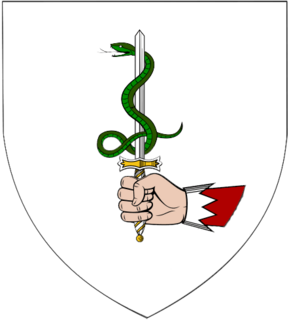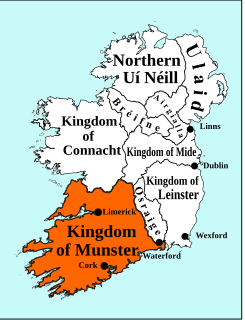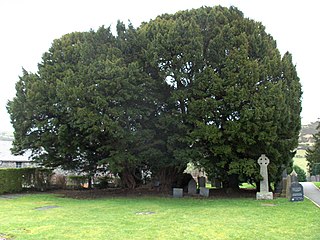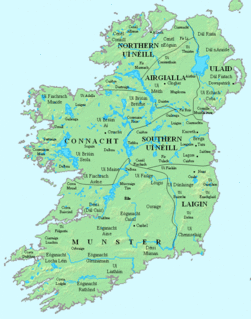
The O'Connell family, principally of Derrynane , are a Gaelic Irish noble family of County Kerry in Munster. The principal seat of the senior line of the family was Derrynane House, now an Irish National Monument.

The O'Connell family, principally of Derrynane , are a Gaelic Irish noble family of County Kerry in Munster. The principal seat of the senior line of the family was Derrynane House, now an Irish National Monument.
According to tradition, they descend from the ancient Uí Fidgenti (Uí Chonaill Gabra sept) of County Limerick, being descendants of Dáire Cerbba, [1] and are thus cousins of the O'Donovans and O'Collins. Other ancestors, through marriage, include the Kings of Thomond of the great O'Brien dynasty, the MacCarthy Mor dynasty of the great Kingdom of Desmond, the two O'Sullivan dynasties Beare and Mor, O'Callaghan, O'Connor Kerry, O'Donovan of Clancahill, and the O'Donoghue Dhuv sept of O'Donoghue of the Glens. [2] [3] [4] [5] [6]
It has been suggested that the O'Connells are a sept of the Corcu Duibne, the Ua Congaile, a kingdom native to County Kerry. [7] While certainly a possibility, and one demanding more research, there still remains more supporting evidence at this time for a descent from the Uí Chonaill Gabra of County Limerick: a family using the sept name of their former kingdom as their surname following its disintegration is not something unheard of in Ireland, [8] and the claims of Count O'Connell to descent from Dáire Cerbba cannot simply be dismissed as career-minded, when the Uí Fidgenti had long since faded and a Corcu Duibne ancestry would have been no less attractive. A descent from the Corcu Duibne would make the O'Connells of Derrynane kin to the O'Sheas and O'Falveys, and descendants of the legendary Conaire Mór, ancestor also of the Dál Riata monarchs of Scotland.
Thus the O'Connells are not technically allowed to be of royal extraction because they cannot conclusively prove their patrilineal ancestors to have been kings of any specific septs or territories, even if they might have been. But through marriage they are closely related to the various ancient royal families of Munster, and in fact to a greater extent than those are to each other. The province of Munster was itself divided into several exclusive provinces but the O'Connells were successful in bridging this.
Cousins of the O'Connells of Derrynane were Sir Maurice Charles O'Connell and son Maurice Charles O'Connell (Australian politician). Another cousin was Daniel O'Connell (journalist).
This article concerns the Gaelic nobility of Ireland from ancient to modern times. It only partly overlaps with Chiefs of the Name because it excludes Scotland and other discussion. It is one of three groups of Irish nobility, the others being those nobles descended from the Hiberno-Normans and those granted titles of nobility in the Peerage of Ireland.
Mongfind —meaning "fair hair" or "white hair"—is a figure from Irish legend. She is said to have been the wife, of apparent Munster origins, of the legendary High King Eochaid Mugmedón and mother of his eldest three sons, Brión, Ailill and Fiachrae, ancestors of the historical Connachta. She was Eochaid's first wife; his second wife, Cairenn, gave birth to Niall of the Nine Hostages. Several tales depict Mongfind as an adversary of Niall. Mongfind is also said to have been the sister of Crimthann mac Fidaig, King of Munster and the next High King of Ireland, whom she is said to have killed with poison in a bid to make her son king. She drank the poisoned drink to convince Crimthann, and died soon after at Samhain.

The Iverni were a people of early Ireland first mentioned in Ptolemy's 2nd century Geography as living in the extreme south-west of the island. He also locates a "city" called Ivernis in their territory, and observes that this settlement has the same name as the island as a whole, Ivernia. The name Iverni has been derived from Proto-Indo-European *PiHwerjoHn, "the fertile land". It was probably once the name given to all the peoples of Ireland, but by Ptolemy's time had a more restricted usage applicable to the inhabitants of the south-west. These Iverni can be identified linguistically with the Érainn, a people attested in Munster and elsewhere in the early Middle Ages.

The Eóganachta or Eoghanachta were an Irish dynasty centred on Cashel which dominated southern Ireland from the 6/7th to the 10th centuries, and following that, in a restricted form, the Kingdom of Desmond, and its offshoot Carbery, to the late 16th century. By tradition the dynasty was founded by Conall Corc but named after his ancestor Éogan, the firstborn son of the semi-mythological 3rd-century king Ailill Aulom. This dynastic clan-name, for it was never in any sense a 'surname,' should more accurately be restricted to those branches of the royal house which descended from Conall Corc, who established Cashel as his royal seat in the late 5th century.

The O'Donovans are an Irish family. Their patronymic surname derives from Irish Ó Donnabháin, meaning the grandsons or descendants of Donnubán, referring to the 10th century ruler of the Uí Fidgenti, Donnubán mac Cathail. During the 12th and 13th century, O'Donovan relations relocated from the Bruree/Croom area south to the Kingdom of Desmond and to Carbery, where they were a ruling family for centuries and played a role in the establishment of a feudal society under the MacCarthys. Other septs retreated into the southeast corner of the Ui Fidgheinte territory, reaching from Broadford/Feenagh to the Doneraile area. The northern septs of the O'Donovans did not use a White Rod as the family's position in their original territory was vastly eroded, while several septs of O'Donovans in the southwest territories were semi-autonomous flatha under the MacCarthy Reagh dynasty in Carbery, with the most notable being local petty kings. The family were counted among the leading Gaelic nobility of Ireland.

The Kingdom of Munster was a kingdom of Gaelic Ireland which existed in the south-west of the island from at least the 1st century BC until 1118. According to traditional Irish history found in the Annals of the Four Masters, the kingdom originated as the territory of the Clanna Dedad, an Érainn tribe of Irish Gaels. Some of the early kings were prominent in the Red Branch Cycle such as Cú Roí and Conaire Mór. For a few centuries they were competitors for the High Kingship or Ireland, but ultimately lost out to the Connachta, descendants of Conn Cétchathach. The kingdom had different borders and internal divisions at different times during its history.
Ólchobar mac Flainn was a supposed King of Munster from the Uí Fidgenti of County Limerick, allies and/or distant cousins of the Eóganachta. He was the first non-Eóganachta to be considered king in some sources. He belonged to a branch of the Uí Fidgenti known as the Uí Conaill Gabra, ancestors of the later famous septs of O'Connell of Kerry and Ó Coileáin of Carbery. His father Flann mac Erca and brother Scandlán mac Flainn were kings of the Uí Fidgenti.

Dáire Cerbba was a 4th-century Irish dynast who was evidently a king of late prehistoric central northern Munster, called Medón Mairtíne at the time. A frequently believed grandson of his, Crimthann mac Fidaig, was High King of Ireland and some British territories, and another descendant Bressal mac Ailello may have been King of Munster, and whose sister Angias was Queen of Lóegaire mac Néill, High King of Ireland. Finally, another descendant, according to Geoffrey Keating, was a king of Munster named Cormac, son of Ailill, son of Eochaid, son of Dáire Cearb.
The Dáirine, later known dynastically as the Corcu Loígde and associated, were the proto-historical rulers of Munster before the rise of the Eóganachta in the 7th century AD. They were derived from or closely associated with the Darini of Ptolemy and were also related to the Ulaid and Dál Riata of Ulster and Scotland. Their ancestors appear frequently in the Ulster Cycle. In historical times the Dáirine were represented, as stated, by the Corcu Loígde, the Uí Fidgenti and Uí Liatháin, as well as a few other early historical kindreds of both Munster and Ulster. In ancient genealogical schemes, the historical Dál Fiatach of Ulaid also belong to the Dáirine.
The Corcu Loígde, meaning Gens of the Calf Goddess, also called the Síl Lugdach meic Itha, were a kingdom centred in West County Cork who descended from the proto-historical rulers of Munster, the Dáirine, of whom they were the central royal sept. They took their name from Lugaid Loígde "Lugaid of the Calf Goddess", a King of Tara and High King of Ireland, son of the great Dáire Doimthech. A descendant of Lugaid Loígde, and their most famous ancestor, is the legendary Lugaid Mac Con, who is listed in the Old Irish Baile Chuinn Chétchathaig. Closest kin to the Corcu Loígde were the Dál Fiatach princes of the Ulaid.
The Uí Fidgenti, Fidgeinti, Fidgheinte, Fidugeinte, Fidgente, or Fidgeinte were an early kingdom of northern Munster in Ireland, situated mostly in modern County Limerick, but extending into County Clare and County Tipperary, and possibly even County Kerry and County Cork, at maximum extents, which varied over time. They flourished from about 377 AD to 977, although they continued to devolve for another three hundred years. They have been given various origins among both the early or proto-Eóganachta and among the Dáirine by different scholars working in a number of traditions, with no agreement ever reached or appearing reachable.

The Corcu Duibne, which means "seed or tribe of Duibhne", was a notable kingdom in prehistoric and medieval County Kerry, Ireland which included the Dingle Peninsula, the Iveragh Peninsula and connecting lands. The tribe belonged to the Érainn and claimed descent from the legendary Conaire Mór, possibly making them distant cousins of such far off kingdoms as Dál Riata in Ulster and Scotland, as well as the closer Múscraige and Corcu Baiscind. All the tribes belonged to the Síl Conairi of legend and ultimately traced their descent from the Clanna Dedad.
Íar mac Dedad was a legendary King of Munster. He is the father, or in some sources more distant ancestor, of Eterscél Mór, and grandfather of the famous Conaire Mór, both High Kings of Ireland.
Deda mac Sin was a prehistoric king of the Érainn of Ireland, possibly of the 1st century BC. Variant forms or spellings include Ded, Dedu, Dedad, Degad, Dega, Dego, Deguth and Daig, with some of these occurring as genitives although usage is entirely unsystematic, besides the rare occurrence of the obvious genitive Dedaid. He is the eponymous ancestor of the Clanna Dedad, and may also have been a King of Munster.

The Corcu Baiscind were an early Érainn people or kingdom of what is now southern County Clare in Munster. They descended from Cairpre Baschaín, son of Conaire Cóem, a High King of Ireland. Closely related were the Múscraige and Corcu Duibne, both of Munster, and also the Dál Riata of Ulster and Scotland, all belonging to the Síl Conairi of legend. A more distant ancestor was the legendary monarch Conaire Mór, son of Eterscél, son of Íar, son of Dedu mac Sin.

Ó Coileáin is a Modern Irish surname generally belonging to the descendants of the last leading family of the Uí Chonaill Gabra, a sept and small but notable overkingdom of medieval and ancient Ireland, based in western County Limerick. Throughout much of their history the Uí Chonaill Gabra were in turn the leading sept of the greater regional overkingdom of the Uí Fidgenti, considered among the highest ranked princes or flatha in all the Province of Munster. Ó Coileáin/Ua Cuiléin is most commonly anglicized O'Collins and O'Cullane. The surname has also long been found in County Cork, believed largely due to the migration there, probably in the late 12th or early 13th century, of a junior branch of the County Limerick dynasty.
The Corca Oíche, meaning "the race of Oíche" was an ancient tribe, possibly of Pictish origin, existing since pre-Christian times in Ireland. It is possible that they descend from the Cruthin, a people whose territory existed near Lough Neagh in north-east Ireland. As such, some sources claim that they descended from the semi-legendary hero Dubthach Dóeltenga, or more commonly that they are descended from Oíche or Óchae, the daughter of Cronn Badhraoi of the Dál nAraidi, and her son Fergus Foga last king of the Ulaid to rule at Emain Macha.
Máire Ní Dhonnchadha Dhuibh was an Irish poet.